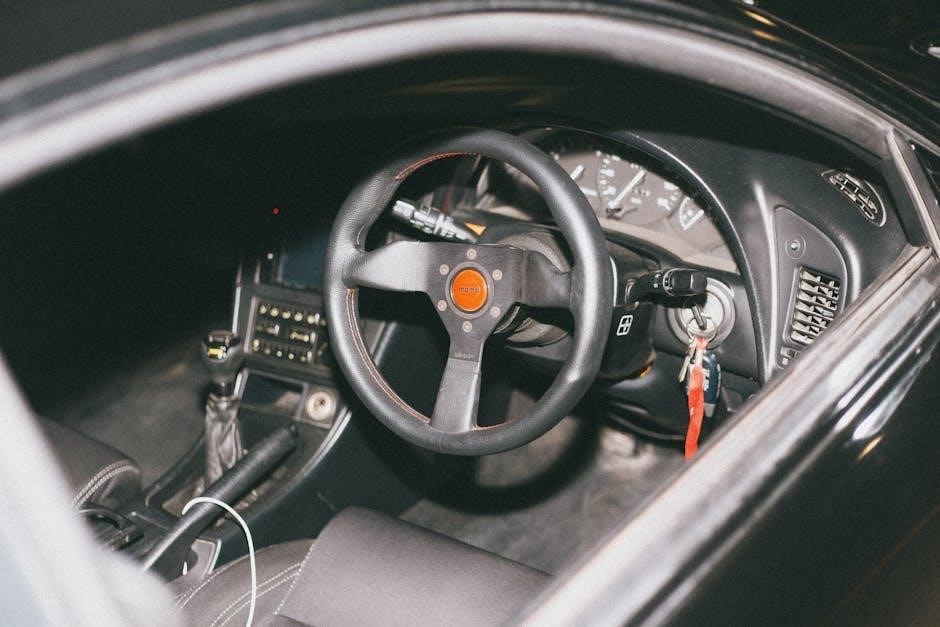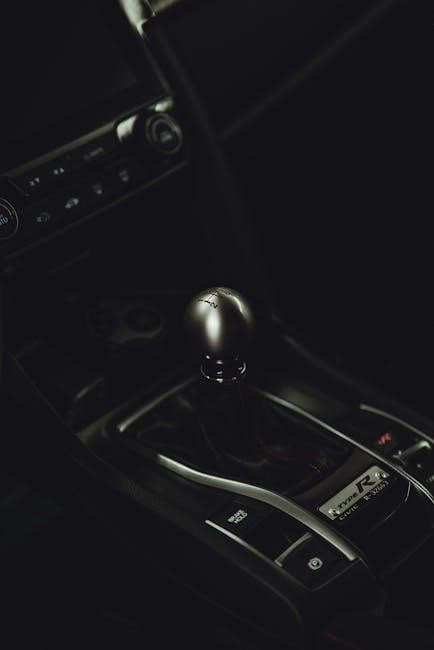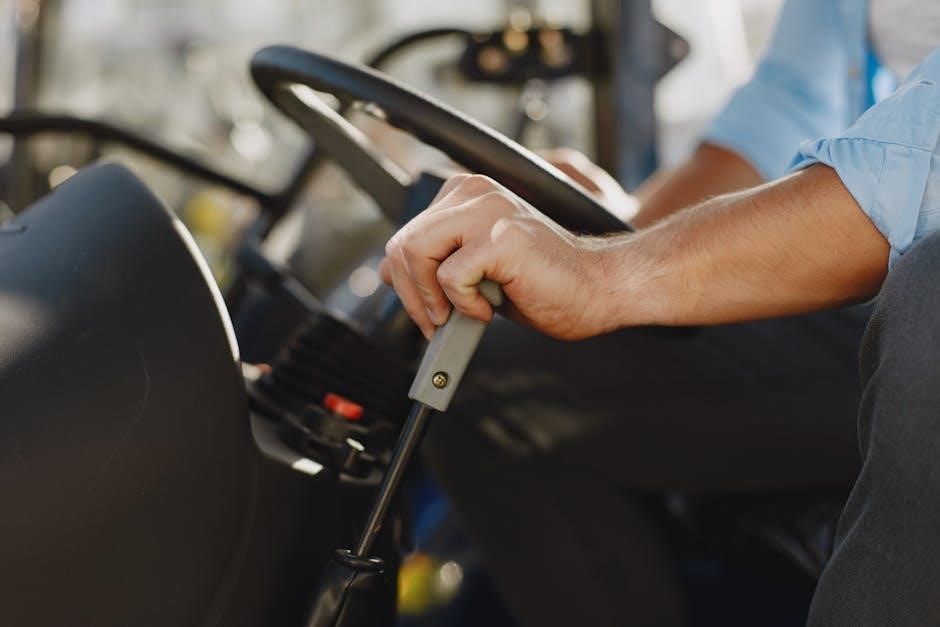Three-speed manual transmissions were a cornerstone of mid-20th-century automotive design, offering simplicity, durability, and reliability. They became a standard feature in many vehicles, favored by drivers for their ease of use and fuel efficiency.
Definition and Basic Functionality
A 3-speed manual transmission is a type of gearbox that allows drivers to manually select one of three forward gear ratios. It operates through a clutch pedal and a gearstick, requiring the driver to engage and disengage gears sequentially. This system relies on mechanical components to transfer power from the engine to the wheels, providing control over acceleration and speed. The simplicity of three gears makes it lightweight and straightforward to maintain, with each gear ratio designed for specific driving conditions, such as low-speed maneuvering or highway cruising. Its functionality is rooted in mechanical efficiency, offering a direct connection between the driver and the vehicle’s performance.
Historical Context and Evolution
The 3-speed manual transmission emerged in the early 20th century as a simple, reliable solution for early automobiles. By the 1920s, it became a standard feature in many vehicles, offering three forward gears for basic driving needs. Its popularity peaked in the mid-20th century, particularly in North America, where it was widely used in both cars and trucks until the 1970s. Early designs often featured column-mounted shifters, while later models introduced floor-mounted options for better driver convenience. Over time, the 3-speed manual was gradually replaced by transmissions with more gears, offering improved performance and efficiency. Despite this, it remains iconic in vintage vehicles and nostalgic driving experiences.

Design and Components
A 3-speed manual transmission consists of a gear set, bearings, and a shift mechanism. Its compact design ensures smooth gear transitions, with components working in harmony for reliable performance.
Key Components of a 3-Speed Manual Transmission
A 3-speed manual transmission includes a gear set, bearings, and a shift mechanism. The gear set consists of three forward gears and one reverse gear, mounted on shafts. Bearings ensure smooth gear rotation, while the shift mechanism, including a shift fork and synchromesh, facilitates gear changes. The transmission housing encases these components, providing structural integrity. A clutch pedal engages and disengages the engine from the transmission, allowing manual gear selection. Column-shift and floor-shift designs differ in shifter placement but share core mechanical principles. Together, these components enable drivers to control vehicle speed and torque efficiently, making the 3-speed manual a reliable, straightforward system for its time.
Column-Shift vs. Floor-Shift Designs
Column-shift and floor-shift designs were two primary configurations for 3-speed manual transmissions. Column-shift transmissions, common in North America during the 1940s and 1950s, featured a shifter mounted on the steering column, simplifying cabin layout. This design was particularly popular in trucks and larger vehicles, as it freed up floor space. In contrast, floor-shift designs placed the shifter between the driver and front passenger, offering better ergonomics and driver control. While column-shifts remained prevalent in trucks until the late 1980s, floor-shifts became synonymous with sportier, driver-focused vehicles. Both designs catered to different driving preferences and vehicle types, reflecting evolving automotive priorities.

Historical Applications
Three-speed manual transmissions were widely used in vehicles from the 1920s to the 1970s, becoming a standard in cars and trucks for their simplicity and reliability.
Cars and Trucks Commonly Equipped with 3-Speed Manuals
Three-speed manual transmissions were commonly found in classic vehicles like the Willys Jeep CJ5, Chevrolet 3100 Pickup, and early Ford models. These transmissions were popular for their simplicity and durability, making them ideal for both urban and rural driving. The Ford Toploader, introduced in 1963, became a staple in many trucks and cars, offering a reliable three-speed option. Additionally, vehicles like the 1958 Chevrolet 3100 Pickup and the 1955 Chevrolet models often featured these transmissions. Their widespread use in trucks and cars during the mid-20th century highlights their practicality and enduring appeal for drivers seeking a straightforward, no-frills driving experience.

The Role of 3-Speed Manuals in Vintage Vehicles
Three-speed manual transmissions hold a significant place in vintage vehicles, embodying simplicity and mechanical authenticity. They were integral to the driving experience of classic cars and trucks, offering a direct connection between driver and machine. Vintage models like the 1958 Chevrolet 3100 and Willys Jeep CJ5 relied on these transmissions for their durability and ease of maintenance. The column-shift design, prevalent in many vintage vehicles, added a unique charm and functionality. Today, these transmissions are sought after by enthusiasts for restorations and nostalgia, preserving the heritage of early automotive engineering and providing a tangible link to the past for modern drivers who appreciate traditional craftsmanship.
Drivability and Efficiency
Three-speed manual transmissions offered simplicity and durability, providing a direct driving experience. However, they lacked the efficiency of modern multi-speed transmissions in various driving conditions.
Advantages of a 3-Speed Manual in Urban Driving
A 3-speed manual transmission offers simplicity and ease of use, making it ideal for urban driving. Its mechanical efficiency ensures better fuel economy in stop-and-go traffic. The lightweight design reduces energy loss, enhancing responsiveness in low-speed environments. Maintenance is straightforward, with fewer components compared to modern transmissions. Drivers appreciate the direct control and predictable performance, which aids in navigating tight city spaces. Additionally, the lower weight contributes to better agility, making it easier to maneuver in congested areas. These factors combine to create a practical and reliable choice for city driving, where simplicity and efficiency are prioritized over high-speed performance.

Limitations in Modern Driving Scenarios
Modern driving scenarios often highlight the limitations of 3-speed manual transmissions. With only three gears, these transmissions struggle to keep engines in optimal RPM ranges, leading to reduced fuel efficiency on highways. The lack of additional gears makes it difficult to maintain smooth acceleration, especially on inclines or when merging. In heavy traffic, constant shifting can be cumbersome, and the absence of overdrive gears results in higher engine wear at higher speeds. Additionally, the limited gear ratio spread can make driving in hilly or mountainous regions less efficient. These shortcomings make 3-speed manuals less practical for today’s driving demands compared to modern multi-speed transmissions.

Maintenance and Repair
Regular maintenance of a 3-speed manual transmission involves checking and changing the transmission fluid, ensuring smooth operation. Lubrication of gears and inspections of gaskets are essential for preventing wear and leaks.
Common Maintenance Tasks for 3-Speed Manuals
Regular maintenance for 3-speed manual transmissions includes fluid checks and changes to ensure smooth gear engagement. Cleaning the transmission filter and inspecting gaskets for leaks are essential. Lubrication of moving parts prevents wear, while checking the clutch operation ensures proper shifting. Additionally, monitoring the transmission mounts for stability and inspecting the gearshift linkage for tightness help maintain drivetrain integrity. These tasks are straightforward and prevent major repairs, ensuring the transmission remains efficient and reliable over time.
Repair Challenges and Solutions
Repairing a 3-speed manual transmission can be challenging due to worn-out components like synchronizers, gear teeth, and bearings. Replacing these parts often requires specialized tools and expertise. Leaks from the transmission case or seals are common issues, requiring disassembly for proper sealing. DIY repairs can be complex, as accessing internal components may involve removing the transmission. However, many aftermarket parts are available, making repairs feasible; Consulting a professional mechanic is recommended for intricate fixes, ensuring longevity and performance. Regular maintenance can prevent major repairs, but when issues arise, timely intervention is crucial to avoid further damage.
Modern Alternatives
Modern transmissions now feature 4-speed, 5-speed, or automatic options, offering improved performance, fuel efficiency, and smoother shifting, making them preferred choices over traditional 3-speed manuals.
Upgrading to 4-Speed or 5-Speed Manual Transmissions
Upgrading from a 3-speed to a 4-speed or 5-speed manual transmission enhances drivability by providing more gear ratios, better engine control, and improved fuel efficiency. Modern drivers benefit from smoother acceleration and reduced wear on the engine. These transmissions are particularly advantageous in both urban and highway driving, allowing for optimal power delivery across various speeds. Additionally, aftermarket solutions like the Tremec TKO 5-speed offer compatibility with classic vehicles, enabling enthusiasts to modernize their cars without losing the manual driving experience. This upgrade is popular among those seeking a balance between performance and practicality in their vehicles.
The Rise of Automatic Transmissions

The rise of automatic transmissions marked a significant shift in automotive technology, prioritizing convenience and ease of use. Automatics offered smoother acceleration and reduced driver effort, particularly in urban driving with frequent stops. Modern automatic transmissions boast improved efficiency and performance, making them a preferred choice for many drivers. Industry data shows a steady decline in manual transmission usage, with only 1.7% of new U.S. car models sold featuring manual transmissions. This trend underscores the growing appeal of automatics, driven by advancements in technology and changing consumer preferences. The proliferation of automatic transmissions continues to shape the future of the automotive industry, emphasizing comfort and practicality.
The 3-speed manual transmission, once an automotive staple, has largely been succeeded by modern alternatives like automatics. Despite this, its legacy endures, cherished by classic car enthusiasts.
Legacy of the 3-Speed Manual Transmission
The 3-speed manual transmission holds a significant place in automotive history, serving as a reliable and straightforward solution for drivers during the mid-20th century. Its simplicity and durability made it a preferred choice for both cars and trucks, particularly in the 1940s to the 1970s. Many classic vehicles, such as the 1955 Chevrolet and 1957 Chevrolet, featured this gearbox, which became synonymous with American automotive culture. Although it has largely been replaced by modern transmissions, the 3-speed manual remains a cherished piece of nostalgia, celebrated by vintage car enthusiasts for its mechanical charm and historical relevance.

Future Prospects in the Automotive Industry
While 3-speed manual transmissions are largely overshadowed by modern multi-speed alternatives, they retain a niche appeal among vintage car enthusiasts and restorers. The rise of automatic transmissions and advanced manual gearboxes has reduced their practicality in contemporary vehicles. However, their simplicity and durability make them a favorite for classic car restorations and retro builds. Additionally, aftermarket support continues to provide parts and solutions for maintaining these transmissions. As the automotive industry evolves, the 3-speed manual is unlikely to regain mainstream popularity but will remain a cherished relic for those who appreciate its mechanical simplicity and historical significance.

